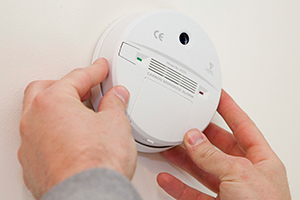TYPES OF DETECTOR
CO detectors are designed to warn of presence of CO and are generally available as mains electricity or battery operated devices. Although generally not recommended, spot detectors are also available. CO detectors, whether electrical/battery operated or spot detector type, are designed to detect excessive levels of CO within the area they are installed, giving an audible or visual warning, subject to their design limitations and the nature of the area installed. Mains and battery operated devices CO detectors should conform to BS 7860-1996 and those produced after November 2006 should conform to EN 50291.
Examples of mains electricity and battery operated CO detectors
The standard for these types of CO detectors require them to respond to CO levels as follows:
- Within 6 minutes at CO levels of 350 ppm
- At levels of 150 ppm the alarm should sound within 10-30 minutes
- At levels of 45 ppm the alarm should not sound for 60 minutes. They can also have a variety of additional features including external switching options for, gas safety shut off valves and remote audible alarms. Lifespans can vary, check manufacturers instructions.
Spot Detectors
This type of detector uses an orange coloured spot that turns to grey or black when CO is detected at levels as low as 100 ppm. The reaction times and life span of the spot detectors are variable.
Spot Detectors are a cheap, easy to install method of monitoring the atmosphere for CO. However, they can be damaged or indeed neutralised by halogens, nitrous gases and ammonia (e.g. house-hold cleaning products). For this reason the detector should be sited away from cleaning materials, solvents and other contaminants.
They should be fixed at eye level near the appliance and checked regularly to see if the spot has darkened.
A significant drawback with these devices is the fact that they do not give off an audible alarm and given that symptoms of CO poisoning will inevitably lead to the occupants of the room falling asleep before entering a coma, an audible signal could be considered essential. In actual practice, they are easily ignored or forgotten.
SITING OF CO DETECTORS (Mains and battery operated)
CO can contaminate areas at considerable distances from the source.
CO is of approximately the same relative density as air at the same temperature, but as it is caused during combustion it will be lighter than the surrounding air and will circulate by convection around the room.
The correct positioning of detectors is extremely important, and manufacturers instructions must always be followed. In general, the rules below should be followed: ¦ Should be located in the same room as the appliance, and if partitioned, within the same area as the appliance
- Located at a height greater than any door, window or air vent, but at least 150 mm from the ceiling
- If fitted on the ceiling it should be 300 mm from any wall and should be between 1 m and 3m from the appliance
- If within a room with a sloping ceiling, it should be located at the high side of the room
- If fitted within bedrooms or sleeping areas remote from the appliance they should be fitted close to the breathing area of the occupants
- Detectors should be fitted in every room containing an open flued/flueless gas appliance.
Detectors should NOT be fitted in the following locations:-
- Outside the building
- In or below a cupboard
- In a damp or humid area
- Directly above a sink, cooker or any flueless appliance
- Next to a door, window or any area that would be affected by draughts
- In an area where it could be obstructed, knocked, damaged or blocked by dust or dirt
- In an area where the temperature could be <10°C or >40°C
At Stockbridge Boilers we take your safety very seriously. Therefore we highly suggest to all of our customers that they have a CO Detector installed. Just ask our technicians if you would like to know more.
